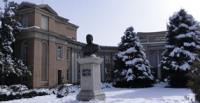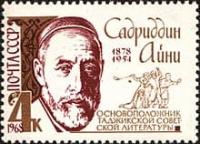Вы здесь
Academy of Sciences of Tajikistan.


Destinations in Central Asia and Tajikistan.
“He is not a man and not a scientist who does not keep in his heart the annals of the past. But the one who comprehended the history of the departed, he added many lives to his own.”
Shihab ad-din an-Nasawi.
Architecture of Dushanbe.
Academy of Sciences of Tajikistan is located on Rudaki Avenue, 33 corner of Hussein-zade Street, 300 meters northwest of the 800th Anniversary of Moscow Square in the Shokhmansur district of Dushanbe. The Academy of Sciences of Tajikistan is the leading higher scientific institution of the republic.
Academy of Sciences of Tajikistan in early 30s of the XX century.
First, in 1932, the first scientific complex institution of the republic was created - the Tajik base of the USSR Academy of Sciences with the sectors of geology and biology. In Tajikistan, systematic research work began, which was carried out by scientists from the USSR Academy of Sciences in the form of complex expeditions, the tasks of which included studying the history and culture of the Tajik people, the natural resources of the republic, creating stationary research centers and training scientific personnel.
These expeditions, which brought together geographers, geologists, botanists, zoologists, geodesists, economists, scientists of other specialties, collected colossal primary material, which then served as the basis for a systematic and purposeful scientific search.
A lot of work has been done to study the flora and fauna of Tajikistan, identify its hydropower, mineral and fuel resources, outline the prospects for the development of new land and industrial development of the republic based on the use of its subsoil.
The results of the work of the expeditions were heard and discussed by the commission of the USSR Academy of Sciences, and a decision was made to organize the Tajik base of the USSR Academy of Sciences for permanent research work on the territory of the republic.
Academy of Sciences of Tajikistan in 1933.
In January 1933, the Tajik base of the Academy of Sciences of the USSR was opened, its first director was Academician S.F. Oldenburg (1863-1935). The base united the sectors of geology, botany, zoology and parasitology, soil science, and the humanities.
As a result of the work of the Tajik base of the USSR Academy of Sciences, it became necessary to create larger specialized scientific institutions - institutions capable of solving important fundamental problems.
Academy of Sciences of Tajikistan in 1940.
In 1941, the Base was reorganized into the Tajik branch of the USSR Academy of Sciences, headed by Academician E. N. Pavlovsky, in 1951 the Academy of Sciences of Tajikistan was established. The Tajik base of the USSR Academy of Sciences was transformed into the Tajik branch of the Academy of Sciences
USSR with institutes: geology, botany, zoology and parasitology, history, language and literature. The Tajik Branch of the Academy of Sciences of the USSR was headed by Academician E.N. The organization of the branch contributed to the further development of science in Tajikistan, despite the fact that its activities coincided with the difficult years of the Great Patriotic War and the post-war period of restoration of the national economy.
As a result of the ten-year activity of the Tajik branch of the USSR Academy of Sciences, the material base for the broad development of scientific research, scientists (more than 700 people) were prepared. As a result, conditions were created for the formation of the Academy of Sciences in the republic.
Academy of Sciences of Tajikistan in 1951 - 1990s.
By the Decree of the Council of Ministers of the USSR of October 9, 1950, on the basis of the Decree of the Presidium of the Supreme Council of the Tajik SSR, the Council of Ministers of the Tajik SSR and the Central Committee of the Communist Party (b) of Tajikistan of April 14, 1951, the Academy of Sciences of the Tajik SSR was established.
In the 50s, inheritances were partly carried out in astrophysics, seismology, geology, chemistry, biology and a number of social problems, and in the 60s mathematics, experimental and theoretical physics, chemistry of oil and natural compounds were developed , physiology and biophysics of plants, economics, history, philosophy, oriental studies, etc.
The supreme governing bodies of the Academy of Sciences are elected. The supreme body is the General Meeting of Academicians and Corresponding Members. A presidium and a president are elected every 4 years to lead between sessions of the General Assembly.
The system of the Academy now has 3 departments and 19 scientific institutions uniting about 1300 scientists, including 580 doctors and candidates of sciences. The structure of the Academy of Sciences of Tajikistan includes: Physical and Technical Institute named after S. U. Umarov (1964), Institute of Astrophysics (1958), Institute of Seismic Construction and Seismology (1951), Institute of Mathematics with a Computing Center (1973), Institute of Geology (1947), Institute of Zoology and Parasitology named after E. N. Pavlovsky (1941), Institute of Plant Physiology and Biophysics (1964), Institute of Gastroenterology (1965), Pamir Institute of Biology (1969), Department of General Cotton Genetics, Section of Social Sciences - Institute of History, Archeology and Ethnography named after Ahmadi Donish (1951), Institute of Language and Literature named after Abuabdullo Rudakn (1951), Institute of Oriental Studies (1970). It included: the Institute of Geology, the Institute of Chemistry, the Institute of Seismology, the Institute of Botany, the Institute of Zoology and Parasitology, the Institute of Soil Science, Melioration and Irrigation, the Institute of Animal Husbandry, the Institute of History, Archeology and Ethnography, the Institute of Language and Literature, the Astronomical Observatory, the Department of Cotton Growing, Department of Philosophy and Department of Economics.
There were two departments in the structure of the Academy of Sciences: natural and social sciences. Thus, in a short historical period in Tajikistan, a path has been passed from scientific cells to the Academy of Sciences - a large research center that unites hundreds of scientists and covers a wide range of problems of modern science with its research.
The Academy of Sciences included 3 honorary academicians - A.N. Nesmeyanov, E.N. Pavlovsky, K.I. Satpaev, 11 academicians and 14 corresponding members. An outstanding worker of science and culture of Tajikistan, the founder of Tajik Soviet literature, Sadriddin Aini (1878 - 1954), who made a huge contribution to the study of the history of the culture of the Tajik people, was elected the first president of the Academy of Sciences of the Tajik SSR.
With the election in 1957 to the post of President of the Academy of Sciences of the Tajik SSR, the famous physicist S.U. Umarov (1900 - 1964), research in the field of exact sciences, experimental biology, and oriental studies intensified.
Since 1951, the Academy has been publishing "Reports" in Tajik and Russian, since 1960 "Izvestia" - 3 sections (in Tajik and Russian), various journals and scientific papers, provides scientific guidance on editions of the Tajik Encyclopedia. The presidents of the Academy of Sciences of the Republic of Tajikistan were in 1951 - 1954. - Sadriddin Aini. From 1954 - 64 - S. U. Umarov, in 1965 - 86. MS Asimov, since 1986 the president of the Academy of Sciences is S. Nemmatullaev.
The development of scientific research in new areas of science required the training of personnel on a large scale. In the scientific institutions of Moscow, Leningrad, Novosibirsk, Kyiv, Minsk and other scientific centers, young Tajik scientists were trained, who began to develop important problems of modern science.
Formed: the Institute of Water Problems, the Institute of Astrophysics, the Department of Oriental Studies and Written Heritage, the Pamir Base of the Academy of Sciences of the Tajik SSR, the Terminology Committee, the Physico-Technical Institute. S.U. Umarova, Institute of Plant Physiology and Biophysics, Institute of Economics, Institute of Gastroenterology, Pamir Biological Institute, Department of Protection and Rational Use of Natural Resources, Institute of Oriental Studies, Mathematical Institute with a Computing Center.
Academy of Sciences of Tajikistan in 1991 - 2000s.
Formed: Institute of Philosophy and Law, Institute of Humanitarian Sciences, Khujand Scientific Center, Pamir Branch of the Academy of Sciences of the Republic of Tajikistan, Department of Materials Science, Department of Human Social Problems.
In order to optimize research activities on September 16, 2010, the Government of Tajikistan adopted a resolution on the structural and administrative reform of the Academy of Sciences of the Republic. According to this decision,
The Institute of Geology and the Institute of Seismic Construction and Seismology of the Academy of Sciences were merged into the Institute of Geology, Earthquake Engineering and Seismology of the Academy of Sciences of the Republic of Tajikistan;
Institute of Botany and Institute of Plant Physiology and Genetics - to the Institute of Botany, Physiology and Genetics of Plants of the Academy of Sciences of the Republic of Tajikistan, Institute of State and Law and Institute of Philosophy. A. Bahovaddinova - to the Institute of Philosophy, Political Science and Law of the Academy of Sciences of the Republic of Tajikistan, Institute of Demography and Institute of Economics - to the Institute of Economics and Demography of the Academy of Sciences of the Republic of Tajikistan, The Institute of Oriental Studies and Written Heritage and the Institute of Language and Literature named after Rudaki - to the Institute of Language, Literature, Oriental Studies and Written Heritage named after Rudaki of the Academy of Sciences of the Republic of Tajikistan.
For 2015, the Academy of Sciences of the Republic of Tajikistan included 16 scientific institutes, which employed 2,000 people. In 2014, the Academy earned 4.5,000,000,000 somoni. The Central Library of the Academy of Sciences has over 1,000,000,000 books. The library has links with scientists from 27 countries of the world and libraries of the Commonwealth countries.
Geographical coordinates of Academy of Sciences in Dushanbe: N38°34'08 E68°47'27
Authority and photos by:
Alexander Petrov.







